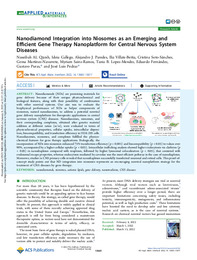Por favor, use este identificador para citar o enlazar este ítem:
https://hdl.handle.net/11000/35183Registro completo de metadatos
| Campo DC | Valor | Lengua/Idioma |
|---|---|---|
| dc.contributor.author | Nuseibah, Al Qtaish | - |
| dc.contributor.author | Gallego, Idoia | - |
| dc.contributor.author | Paredes, Alejandro J. | - |
| dc.contributor.author | Villate Beitia, Ilia | - |
| dc.contributor.author | Soto-Sánchez, Cristina | - |
| dc.contributor.author | Martínez-Navarrete, Gema | - |
| dc.contributor.author | Sainz-Ramos, Myriam | - |
| dc.contributor.author | López-Méndez, Tania B. | - |
| dc.contributor.author | Fernández, Eduardo | - |
| dc.contributor.author | Puras, Gustavo | - |
| dc.contributor.author | Pedraz, José Luis | - |
| dc.contributor.other | Departamentos de la UMH::Histología y Anatomía | es_ES |
| dc.date.accessioned | 2025-01-23T20:03:26Z | - |
| dc.date.available | 2025-01-23T20:03:26Z | - |
| dc.date.created | 2022-03-23 | - |
| dc.identifier.citation | ACS Appl Mater Interfaces . 2022 Mar 23;14(11):13665-13677. | es_ES |
| dc.identifier.issn | 1944-8244 | - |
| dc.identifier.uri | https://hdl.handle.net/11000/35183 | - |
| dc.description.abstract | Nanodiamonds (NDs) are promising materials for gene delivery because of their unique physicochemical and biological features, along with their possibility of combination with other nonviral systems. Our aim was to evaluate the biophysical performance of NDs as helper components of niosomes, named nanodiasomes, to address a potential nonviral gene delivery nanoplatform for therapeutic applications in central nervous system (CNS) diseases. Nanodiasomes, niosomes, and their corresponding complexes, obtained after genetic material addition at different ratios (w/w), were evaluated in terms of physicochemical properties, cellular uptake, intracellular disposition, biocompatibility, and transfection efficiency in HEK-293 cells. Nanodiasomes, niosomes, and complexes fulfilled the physicochemical features for gene therapy applications. Biologically, the incorporation of NDs into niosomes enhanced 75% transfection efficiency (p < 0.001) and biocompatibility (p < 0.05) to values over 90%, accompanied by a higher cellular uptake (p < 0.05). Intracellular trafficking analysis showed higher endocytosis via clathrins (p < 0.05) in nanodiaplexes compared with nioplexes, followed by higher lysosomal colocalization (p < 0.05), that coexisted with endosomal escape properties, whereas endocytosis mediated by caveolae was the most efficient pathway in the case of nanodiaplexes. Moreover, studies in CNS primary cells revealed that nanodiaplexes successfully transfected neuronal and retinal cells. This proof-of-concept study points out that ND integration into niosomes represents an encouraging nonviral nanoplatform strategy for the treatment of CNS diseases by gene therapy. | es_ES |
| dc.format | application/pdf | es_ES |
| dc.format.extent | 13 | es_ES |
| dc.language.iso | spa | es_ES |
| dc.publisher | ACS Publications | es_ES |
| dc.rights | info:eu-repo/semantics/openAccess | es_ES |
| dc.rights | Attribution-NonCommercial-NoDerivatives 4.0 Internacional | * |
| dc.rights.uri | http://creativecommons.org/licenses/by-nc-nd/4.0/ | * |
| dc.subject | CNS diseases | es_ES |
| dc.subject | cationic lipids | es_ES |
| dc.subject | gene delivery | es_ES |
| dc.subject | nanodiamonds | es_ES |
| dc.subject | nanomedicine | es_ES |
| dc.subject | ninosomes | es_ES |
| dc.title | Nanodiamond Integration into Niosomes as an Emerging and Efficient Gene Therapy Nanoplatform for Central Nervous System Diseases | es_ES |
| dc.type | info:eu-repo/semantics/article | es_ES |
| dc.relation.publisherversion | 10.1021/acsami.2c02182 | es_ES |

Ver/Abrir:
Nanodiamond Integration into Niosomes as an Emerging and Efficient Gene Therapy Nanoplatform.pdf
12,8 MB
Adobe PDF
Compartir:
 La licencia se describe como: Atribución-NonComercial-NoDerivada 4.0 Internacional.
La licencia se describe como: Atribución-NonComercial-NoDerivada 4.0 Internacional.
.png)